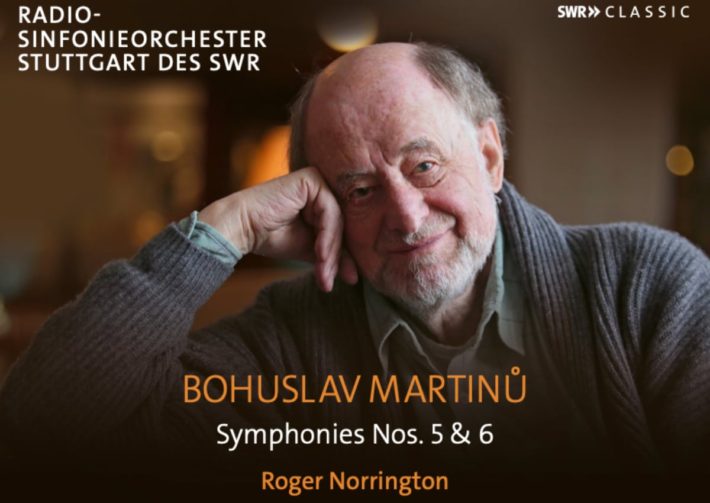This was an unexpected but enjoyable surprise. I know Roger Norrington mainly from his pioneering work with the London Classical Players but the only other 20th century repertoire I have heard him conduct is Symphonies No. 2-6 by Vaughan Williams, played by the London Philharmonic Orchestra on Decca. Frustratingly, the cycle was never completed.
One of the excellent aspects of those Vaughan Williams recordings was the startling transparency Norrington brings to orchestral texture, especially in the fourth and sixth symphonies. The same lucidity is apparent in Martinů’s fifth, and the playing of the Stuttgart orchestra is impressively precise. Following along with a score, every “I” is dotted, every “T” is crossed. The SWR engineers create a wide and deep soundstage that supports the music’s wide dynamic range, including some thrilling bass drum tattoos. Yet the reading feels a little too studied, careful and emotionally distant. Norrington ensures we hear every colorful strand of the orchestration, but the sound lacks weight, especially compared to recordings by Neeme Jarvi (BIS), Bryden Thomson (Chandos) and Jiří Bělohlávek (Sym. 5/Supraphon & Sym. 6/Chandos). This is, at least in part, because Norrington’s notorious disavowal of string vibrato, so the string ensemble sound lacks the variety of colors heard in those other performances.
The first movement’s slow opening is immaculate, everything perfectly placed, though the piano, at least in the first movement, is difficult to hear. But the playing fails to summon an atmosphere – listen to the Czech Philharmonic under Bělohlávek and one immediately feels a quiet foreboding, dispelled in the following Allegro by a saucier playfulness. Norrington gets light and airy textures in the Allegro, but again, the emotional reticence suggests his players do not fully inhabit Martinů’s sound world.
Related
- All Martinů reviews
- Review: Vaughan Williams – Symphonies No. 4 & 6 – LSO, Pappano
- Review: Prokofiev – Violin Concertos Nos 1 & 2 – Tianwa Yang, Violin
The flute solo in the slow movement is touchingly delicate, and at 2’58” Norrington carefully builds the music to a powerful climax. The playing has greater character, the piano now more prominent, though the climax at 4’30” feels reigned in when it should be threateningly explosive, as if we are at the edge of an abyss. Jarvi’s reading has greater forward thrust and a more palpable emotional atmosphere. The violin solo at 6’44,” played without vibrato, has a fragility that convincingly generates a spectral mood.
In the Lento opening of the final movement, the vibrato-less strings lack the weight and darker coloring that Jarvi, and especially Thomson, find in their readings. And the tempo is too slow, lacking forward momentum. In Bělohlávek’s reading with the BBC Symphony Orchestra (Onyx) the music is shaped with greater authority, arriving at the Allegro section forty-five seconds faster than Norrington. Norrington’s Allegro is again well played, clearly articulate and well balanced, but emotionally bland.
Norrington and his orchestra are far more engaged by, and attuned to, the “Fantaisies symphoniques.” Martinů described the work as “without form. And yet something holds it together, I do not know what, but it has a single line, and I have really expressed something in it” While the fifth symphony has a block-like structure, with several repetitive passages, the sixth has an ever-changing variety of melodic and rhythmic material. One senses a more profound connection from the opening measures of the first movement, the music’s spookiness superbly caught, Norrington then impishly guiding the orchestra and listener through the many mercurial changes of mood. The orchestra too, seems more comfortable with the composer’s style. The last movement features some exquisite playing, the coda especially affecting. I assumed from the higher quality of this performance that it was recorded after the fifth and that in intervening years Norrington and his players had developed a fuller understanding of Martinů’s music. In fact, the Fantaisies Symphoniques was recorded first, five years before the performance of the fifth.
Bělohlávek’s Chandos performance of the “Fantaisies symphoniques” is exceptionally fine: the Czech Philharmonic has a greater sophistication, and their sound is far more voluptuous. But Norrington’s vision is captivating, and in the sixth symphony the SWR musicians seemed enthralled by the music. In short, a bland fifth wedded to a wholly successful sixth, in excellent albeit light weight sound. It was the Chandos Bělohlávek recordings that introduced me to Martinů’s music, and while I am grateful for his complete cycle with the BBC Symphony Orchestra (Onyx), I regret that Chandos cycle, which featured stunning sound and riveting interpretations, never reached completion. His later Supraphon cycle, also left incomplete, has less impressive sound, and a more objective interpretational approach.
Liner notes are informative. These are live performances, with applause included after both performances.

Martinů – Symphonies 5 & 6
Radio-Sinfonieorchester Stuttgart des SWR
Sir Roger Norrington – conductor
SWR Music, CD 19119
Recommended Comparisons
Bryden Thomson | Neeme Jarvi | Jiri Belohlavek | Karel Ančerl
Read more classical music reviews or visit The Classic Review Amazon store
Follow Us and Comment:
[wd_hustle id=”HustlePostEmbed” type=”embedded”]











